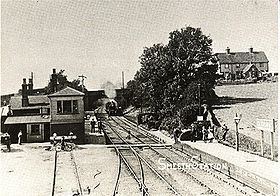Grid reference TR067383 Platforms in use 2 | October 1852 Opened | |
 | ||
Pre-grouping South Eastern RailwaySouth Eastern and Chatham Railway Post-grouping Southern RailwaySouthern Region of British Railways Similar Teston Crossing Halt railw, East Minster railway st, Longfield Halt railway st, Dungeness (SER) railway st, Golden Sands Halt railway st | ||
Smeeth is a disused railway station on the South Eastern Main Line which served the village of Smeeth in Kent, England. The station opened in 1852 and closed in 1954.
History
Smeeth, a scattered village community of a few hundred persons in the early 1840s, was initially ignored by the South Eastern Railway (SER) when it constructed its main line through the area to reach Folkestone. Situated 4.5 miles (7.2 km) from Ashford, the small village was primarily a farming community producing wheat, barley, oats, beans and peas; the grain was processed at Evegate Mill on the River Stour to the south of the railway line, which was the most substantial structure in the area. In 1850, six years after opening the South Eastern Main Line, a deputation of local tradesmen pressed the SER to open a station in the village, arguing that the potential goods traffic that could be generated would outweigh the lack of passenger receipts. Although there was little to suggest that Smeeth could justify and support a railway station, the SER agreed to the venture. A site was chosen 1 mile (1.6 km) to the south of the village at a point where the Bonnington to Smeeth road (now the B2069) crossed the railway line. The land was owned by the Knatchbull-Hugessen family, Sir Edward Knatchbull-Hugessen being the local Member of Parliament and, in later years, a director of the SER.
Rather than the usual wooden clapboard structures so favoured in the construction of SER stations, Smeeth's main station building was instead a substantial multi-gabled brick building. However, other common SER features were to be found at this station, including two staggered platforms and a weather-boarded signal box situated on the up side together with the main station building. The down platform had the minimum of facilities: only a basic wooden waiting shelter and paraffin lamps on "barley-sugar" columns. In 1873, the station facilities were enlarged and the goods yard extended involving the laying of an extra siding, indicating a respectable level of goods traffic. Timetabling of services generally saw eight up and down trains call at Smeeth on weekdays: the first service (up) at 7.25am, and the last service (down) at 9.25pm.
Passenger traffic began to drop following the Second World War as bus services became more popular; the East Kent Road Car Company ran buses which passed close to Smeeth on their way between Ashford and Folkestone, drawing off much of the railway's custom. Nationalisation in 1947 saw the Southern Region of British Railways (BR) take over responsibility for the station, and it began to implement a new policy of centring goods traffic at larger railhead depots, thereby sounding the death knell for many wayside stations across the country whose income was largely down to goods traffic. In 1953, BR proposed the closure of Smeeth Station, arguing that it would save nearly £10,000 in wages and other expenses linked with the renewal of the two platforms; the station, it said, brought in £10,322 in goods receipts and only £143 would be lost from withdrawing passenger services. The local Member of Parliament, Bill Deedes, encouraged villagers to fight the closure, but the local newspaper noted that most preferred to travel by bus or motor car. The station's last passenger train therefore departed at 9.50pm on Sunday 3 January 1954, leaving goods traffic to last for ten more years before Smeeth closed entirely.
The goods yard was let for commercial use after its closure on 18 April 1964, and the buildings later demolished to leave no trace that a station had ever existed on the site.
